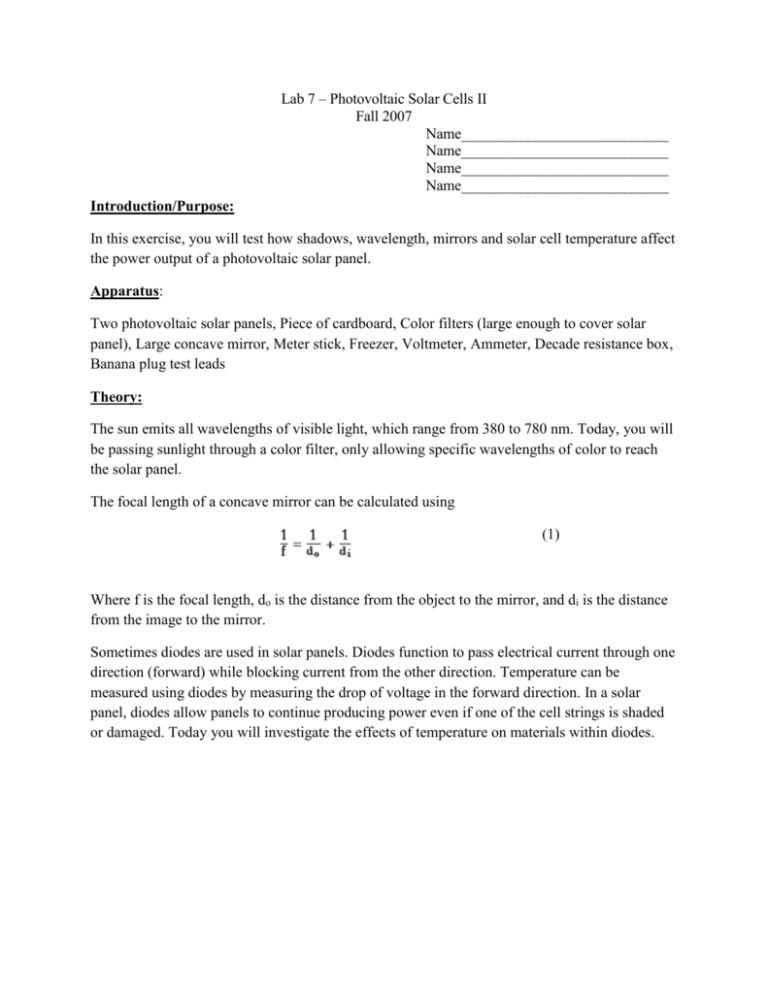Photovoltaics II
advertisement

Lab 7 – Photovoltaic Solar Cells II Fall 2007 Name____________________________ Name____________________________ Name____________________________ Name____________________________ Introduction/Purpose: In this exercise, you will test how shadows, wavelength, mirrors and solar cell temperature affect the power output of a photovoltaic solar panel. Apparatus: Two photovoltaic solar panels, Piece of cardboard, Color filters (large enough to cover solar panel), Large concave mirror, Meter stick, Freezer, Voltmeter, Ammeter, Decade resistance box, Banana plug test leads Theory: The sun emits all wavelengths of visible light, which range from 380 to 780 nm. Today, you will be passing sunlight through a color filter, only allowing specific wavelengths of color to reach the solar panel. The focal length of a concave mirror can be calculated using (1) Where f is the focal length, do is the distance from the object to the mirror, and di is the distance from the image to the mirror. Sometimes diodes are used in solar panels. Diodes function to pass electrical current through one direction (forward) while blocking current from the other direction. Temperature can be measured using diodes by measuring the drop of voltage in the forward direction. In a solar panel, diodes allow panels to continue producing power even if one of the cell strings is shaded or damaged. Today you will investigate the effects of temperature on materials within diodes. Procedure: Wire the circuit as you did in the previous lab. Refer to Figure 1 for a reminder. Load Solar Panel Figure 1: Circuit set up for solar panel Effect of Shadows 1. Take a piece of cardboard and completely block the panel from the sunlight. What is the power output? 2. Measure the dimensions of the solar panel and find area. Block the top 25% of the area of the solar panel going from top to bottom. What is the power output? 3. Increment your blocking out of the sun to 50%, and 75% of the panel, going from the top to the bottom of the panel, and record the power output. 4. Conduct this same experiment, except block out the sun from side to side. Does this make a difference? Why or why not? Effect of Wavelength 1. 2. 3. 4. Hold a color filter above the solar panel so that only that color hits the panel. Record the power output. Repeat this process with several different color filters. Find the wavelength of light that passes through each of these filters. Graph wavelength vs. power output. Effect of Mirrors 1. Obtain a large concave mirror. 2. Calculate the focal point of the mirror. a. Measure the distance from the mirror to an object of your choice. b. Measure the distance from the mirror to the image of the object. c. Use Equation 1 to calculate the focal length. 3. Hold the mirror above the solar panel so the focal point is on the solar panel. 4. Record the power output. 5. Change the angle and distance of the mirror in reference to the solar panel. Compare the power output. Which distance/angle combination results in the most power? Effect of Solar Cell Temperature 1. Place one solar panel in a freezer and while heating another for an hour. 2. Place both panels in the sun and record their power outputs. How do they compare? 3. What effect does temperature have on materials within diodes?






